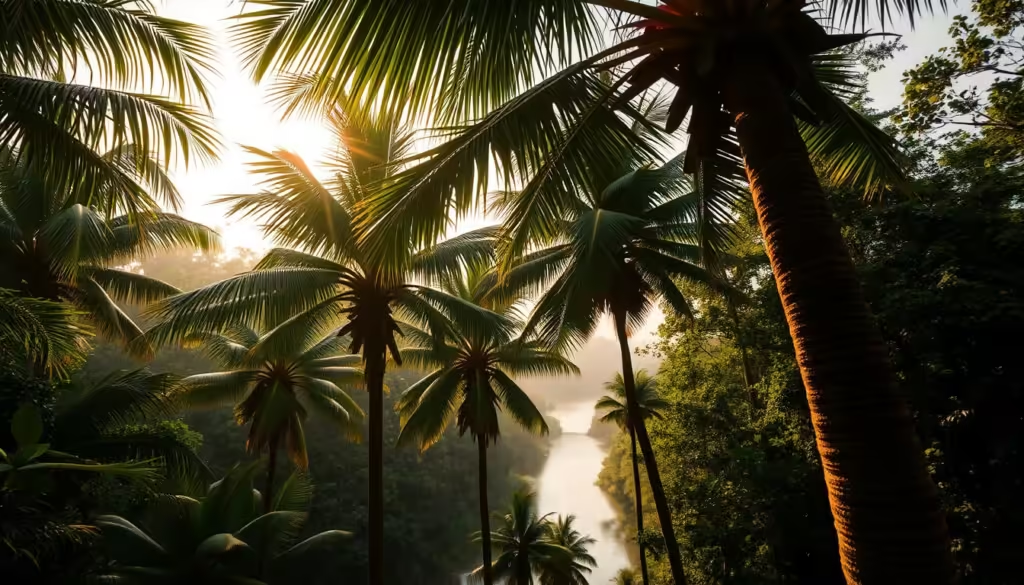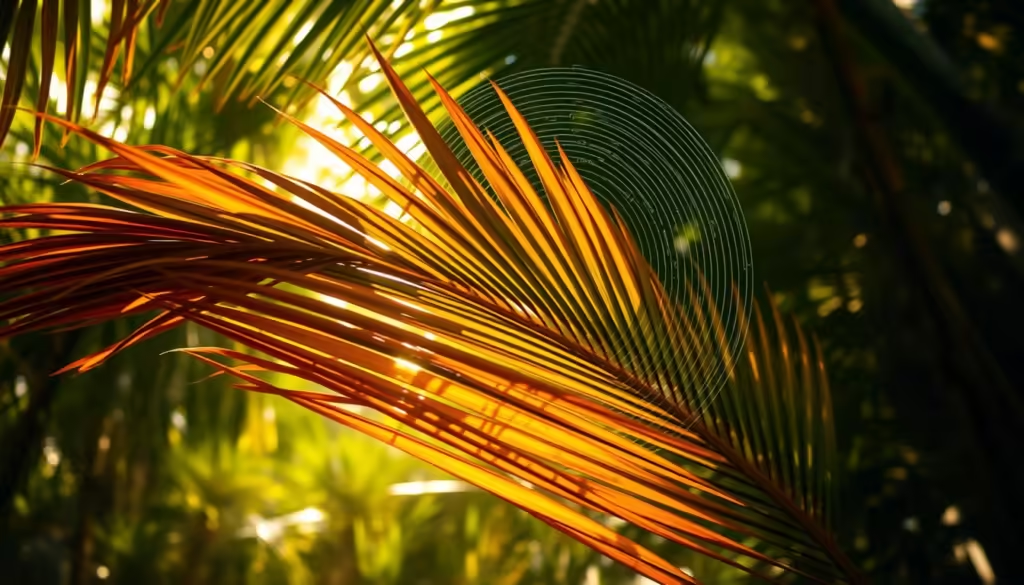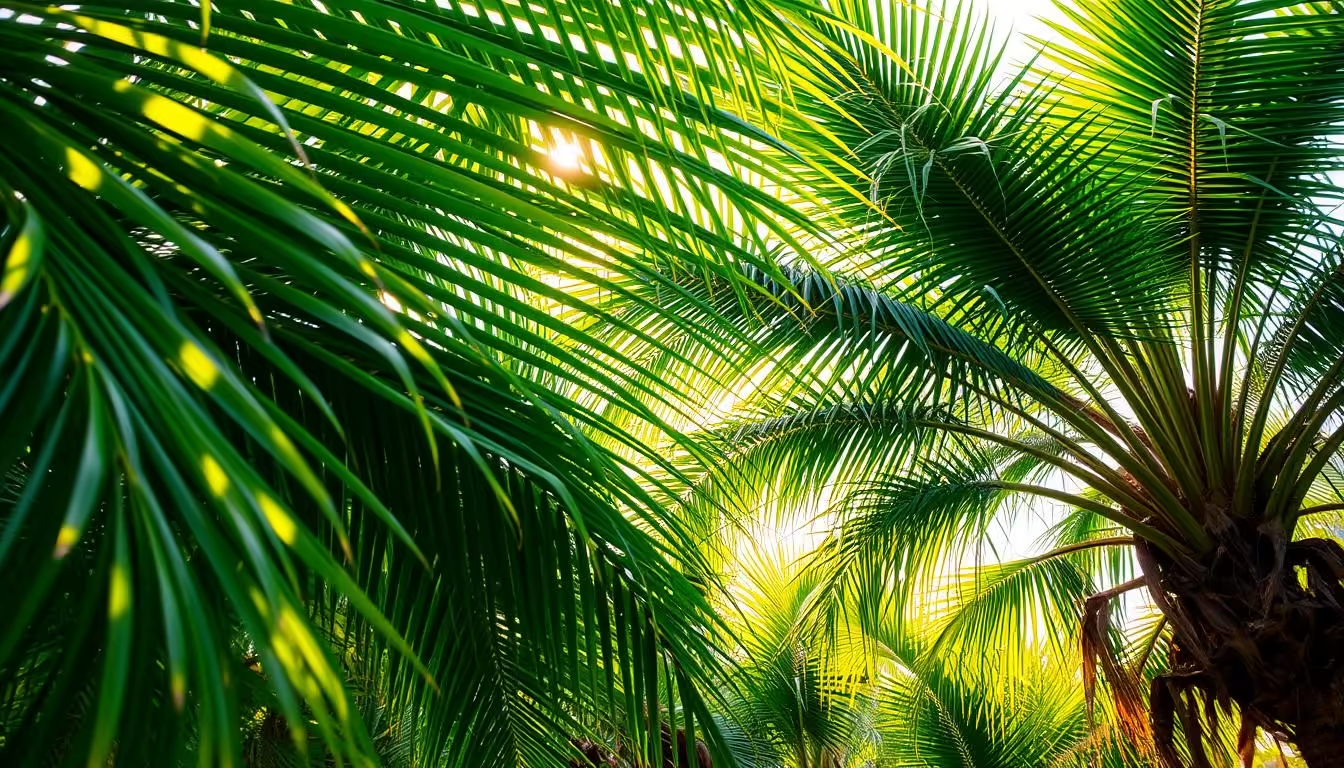A groundbreaking discovery has shed new light on the evolutionary history of certain palm species. It has been found that these plants once utilized the wind to their advantage, using gusts to vibrate their fronds.
This unique adaptation allowed for the effective dispersal of spores, aiding in the propagation of the palms. The vibration of the fronds not only facilitated the spread of spores but also likely played a role in the local ecosystem.
Key Takeaways
- The vibration of fronds aided in spore dispersal.
- This trait was crucial for the propagation of certain palm species.
- The adaptation likely influenced the local microclimate.
- The discovery sheds new light on the evolutionary history of these plants.
- The unique trait highlights the intricate adaptations of these plants to their environments.
The Discovery of Ancient Amazonian Sonic Palms
Amazonian palms with fronds that vibrated in the wind have been a subject of interest since their discovery was hypothesized in 2025. This phenomenon has sparked intense curiosity among botanists and researchers, who are eager to understand the mechanisms behind this unique trait.
The Groundbreaking 2025 Hypothesis
The hypothesis proposed in 2025 marked a significant milestone in the study of Amazonian palms. It suggested that the vibration of palm fronds was not just a peculiar characteristic but a crucial adaptation that aided in propagation. This idea revolutionized the understanding of how these plants dispersed their spores.
Initial Scientific Reactions and Validation
Initially, the scientific community reacted with a mix of curiosity and skepticism. However, as evidence mounted, the hypothesis gained validation. It became clear that the vibration of the fronds played a vital role in the propagation of these palms. The validation of this hypothesis has opened up new research avenues into the dispersal mechanisms of ancient plants.

Amazonian Palms Once Had Fronds Vibrating With Gusts
Unlike their modern counterparts, ancient Amazonian palms had fronds that hummed with the wind. This unique characteristic was due to a complex interplay of structural properties and aerodynamic forces.
The Physical Mechanism Behind Frond Vibration
The vibration of the fronds was caused by the way the wind interacted with their structure. The fronds were specially adapted to respond to gusts, vibrating in a way that was distinct from other plants.
- The structural properties of the fronds allowed for flexibility.
- Aerodynamic forces exerted by the wind caused the fronds to vibrate.
- This vibration was a result of the fronds’ unique adaptation to their environment.

How These Vibrations Generated Distinctive Sounds
As the fronds vibrated, they generated distinctive sounds that were likely an integral part of the ancient Amazonian soundscape. The sounds produced were a result of the frequency and amplitude of the vibrations.
- The frequency of the vibrations determined the pitch of the sound.
- The amplitude of the vibrations affected the loudness of the sound.
- These sounds were unique to the ancient Amazonian palms.
The combination of the physical mechanism and the resulting sounds highlights the fascinating physics underlying the natural world and underscores the unique characteristics of these ancient palms.
Evolutionary Purpose of Vibrating Fronds
The vibrating fronds of ancient Amazonian palms served a crucial evolutionary purpose. This unique adaptation played a significant role in their lifecycle, particularly in enhancing their reproductive capabilities.

Spore Dispersal Enhancement
The vibration of fronds in the wind aided in spreading spores more effectively. This mechanism was crucial for the dispersal of spores over a wider area, increasing the chances of successful germination and establishment of new plants. By enhancing spore dispersal, these palms were able to colonize new areas more efficiently.
Competitive Advantages in Seed Propagation
The vibrating fronds also provided competitive advantages in seed propagation. The dispersal tech inherent in the vibrating mechanism allowed these palms to outcompete other species for resources and habitat. It aided propagation by ensuring that seeds were dispersed over a broad area, reducing competition among the offspring and increasing the likelihood of successful establishment.
In summary, the evolutionary purpose of vibrating fronds was multifaceted, enhancing both spore dispersal and seed propagation. This adaptation was key to the success of ancient Amazonian palms in their ecosystems.
Anatomical Differences Between Ancient and Modern Palms
The anatomical differences between ancient Amazonian palms and their modern counterparts are quite striking. Ancient palms had several distinct features that allowed them to thrive in their environment.

Structural Adaptations for Air Humming
Unlike modern palms, these hummed air due to their unique structural adaptations. The fronds of ancient Amazonian palms were designed to vibrate in the wind, producing a humming sound. This was made possible by:
- Thinner, more flexible fronds
- A specialized vascular system
- A unique arrangement of leaflets
Why Modern Palm Species Lost This Trait
Over time, modern palm species lost the trait of humming in the air, likely due to changes in their environment and evolutionary pressures. As the climate and ecosystem evolved, the need for this adaptation diminished, and palms that did not expend energy on producing sound had a survival advantage.
Some key differences between ancient and modern palms include:
| Characteristic | Ancient Palms | Modern Palms |
|---|---|---|
| Frond Thickness | Thinner, more flexible | Thicker, less flexible |
| Vascular System | Specialized for vibration | Standard vascular system |
The Science of Palm-Generated Sound Waves
The science behind the “palm music” generated by ancient Amazonian palms is a fascinating area of study. Researchers have been intrigued by the phenomenon of fronds vibrating in gusts, producing distinct sound waves.

Acoustic Properties and Frequencies
The acoustic properties of the sound waves generated by the vibrating fronds are characterized by specific frequencies. “The unique acoustic signature of these sounds is a result of the physical structure of the palms and the wind patterns they were exposed to,” notes a leading researcher in the field. Studies have shown that the frequencies produced were within the range of human hearing, making them potentially significant for various ecological interactions.
How Wind Patterns Affected Vibration Intensity
Wind patterns played a crucial role in determining the intensity of the vibrations and, consequently, the sound waves produced. The varying wind speeds and directions influenced the effectiveness of spore dispersal, a critical aspect of the palms’ reproductive cycle. As one study observed, “The synchronization of frond vibrations with wind patterns was a key adaptation that enhanced the palms’ ability to disperse spores over long distances.”
This understanding of palm-generated sound waves not only sheds light on the evolutionary adaptations of ancient Amazonian palms but also inspires new technologies, such as spore-airing systems that mimic the natural process.
Recreating Ancient Amazonian Ecosystems
To recreate ancient Amazonian ecosystems, we must first understand their dynamics. This involves examining the environmental conditions and the unique adaptations of the plants that inhabited these ecosystems.
The Windy Prehistoric Jungle Environment
The ancient Amazonian rainforest was characterized by a windy prehistoric jungle environment. This trait paints jungles as windy, sowing life through the dispersal of seeds and spores. The strong winds played a crucial role in shaping the ecosystem.
The rustling of leaves and the swaying of trees were not just passive reactions to the wind; they were part of an intricate dance that facilitated the survival and propagation of various species.
| Environmental Factor | Impact on Ecosystem |
|---|---|
| Strong Winds | Dispersal of seeds and spores |
| Vibrating Palms | Enhanced spore dispersal and competitive advantages |
Ecological Interactions Facilitated by Vibrating Palms
The vibrating palms were not just a fascinating phenomenon; they played a significant role in the ecological interactions within the ancient Amazonian ecosystems. These palms contributed to the shaping of their environments through their unique adaptations, facilitating the dispersal of spores and seeds.

The ecological interactions facilitated by the vibrating palms underscore the complexity and interconnectedness of the ancient Amazonian ecosystems. By understanding these dynamics, we can gain insights into the evolution of these ecosystems.
Current Botanical Research on Ancient Palm Mechanisms
Researchers are delving into the mysteries of ancient palms to uncover their secrets and understand their adaptations. This involves a comprehensive study of the mechanisms that allowed these palms to thrive in their environments. By understanding these mechanisms, botanists can gain insights into how these plants contributed to their ecosystems.
Research Methodologies and Challenges
Studying ancient palm mechanisms presents several challenges, including the degradation of plant material over time and the need for advanced technologies to analyze these ancient specimens. Researchers employ various methodologies, such as fossil analysis and comparative studies with modern palm species, to overcome these challenges.
- Fossil record analysis to understand historical adaptations
- Comparative genomics to identify genetic changes over time
- Biomechanical modeling to simulate ancient environments
Key Findings from Recent Studies
Recent studies have revealed that ancient Amazonian palms had unique structural adaptations that enabled them to produce sound waves, potentially aiding in spore dispersal. These findings have significant implications for our understanding of evolutionary adaptations and ecological interactions in ancient ecosystems.
By examining the anatomical differences between ancient and modern palms, researchers can better understand how these plants evolved over time. This knowledge can also inform strategies for conservation and restoration of modern palm species.
Technological Applications Inspired by Vibrating Palm Fronds
By understanding the mechanisms behind vibrating palm fronds, scientists can develop new technologies that mimic the adaptations of ancient Amazonian palms. This biomimetic approach has the potential to inspire innovative solutions in various fields.
Biomimetic Spore-Airing Systems
One of the most promising areas of research is the development of biomimetic spore-airing systems. These systems aim to replicate the way ancient palms dispersed their spores through vibration. By studying the physical mechanisms behind this process, engineers can design more efficient systems for dispersing seeds or other particles in various industrial applications.
The potential applications of such systems are vast, ranging from agriculture to environmental conservation. For instance, biomimetic spore-airing systems could be used to disperse seeds in areas where traditional methods are impractical, enhancing reforestation efforts.
Acoustic Engineering Innovations
The study of vibrating palm fronds has also led to acoustic engineering innovations. Researchers are exploring how the unique acoustic properties of these palms can be used to develop new sound-based technologies. This could include the creation of more efficient sound dampening materials or the development of new musical instruments inspired by the “palm music” of ancient Amazonia.
Furthermore, understanding how wind patterns affected the vibration intensity of palm fronds can inform the design of more effective wind-energy harvesting systems. This showcases the potential for vibrating palm fronds to inspire a wide range of technological advancements.
The Cultural Significance of "Palm Music"
Unveiling the secrets of ancient Amazonian palms reveals a unique aspect of their biology that can be likened to a form of natural music. This phenomenon, often referred to as “palm music,” has captivated researchers and the public alike, offering a glimpse into the prehistoric past of the Amazon region.
The vibrating fronds of these ancient palms generated sounds that were likely an integral part of the ancient Amazonian ecosystem. This discovery unveils ancient sowers, showing how breezes carried their seeds, creating a symphony of sounds that resonated through the prehistoric jungle.
Recreating the Soundscape of Ancient Amazonia
Scientists are now working on recreating the soundscape of ancient Amazonia, using data collected from fossil records and simulations of prehistoric wind patterns. This involves understanding how the physical structure of the palms contributed to the generation of sound and how these sounds might have varied across different environments.
| Aspect | Ancient Amazonian Palms | Modern Palms |
|---|---|---|
| Frond Structure | Specialized for vibration | Less rigid, reduced vibration |
| Sound Generation | Significant sound production | Minimal sound production |
| Ecological Role | Integral to ecosystem soundscape | Limited to visual and shelter roles |
Artistic and Educational Interpretations
The concept of “palm music” has inspired a range of artistic and educational interpretations. Musicians are incorporating these natural sounds into compositions, while educators are using the phenomenon to teach about the biology and ecology of ancient ecosystems.
As we continue to explore and understand the cultural significance of “palm music,” we are reminded of the importance of preserving our natural heritage. By studying these ancient palms and their unique characteristics, we gain not only a deeper understanding of the past but also insights into how we can better conserve the natural world today.
Conclusion: How Ancient Palm Adaptations Reshape Our Understanding of Evolutionary History
The discovery of ancient Amazonian palms with fronds that vibrated in the wind has significantly advanced our understanding of evolutionary history. These amazonian palms once had fronds vibrating with gusts, a unique adaptation that played a crucial role in their survival and propagation.
By studying these adaptations, we gain valuable insights into the complex interactions between plants and their environments. The vibrating fronds not only generated distinctive sounds but also facilitated spore dispersal, showing how breezes carried their seeds to new areas, thus enhancing their reproductive success.
This knowledge enriches our understanding of the past and inspires new technologies, such as biomimetic spore-airing systems and acoustic engineering innovations. As we continue to explore and understand the natural world, we uncover new appreciations for the intricate mechanisms that have shaped the evolution of species over time.
FAQ
What is the significance of the discovery that Amazonian palms once had fronds vibrating with gusts?
The discovery highlights the intricate adaptations that enabled these plants to thrive in their environments and sheds new light on the evolutionary history of these plants.
How did the vibration of the fronds aid in the propagation of Amazonian palms?
The vibration of the fronds facilitated the dispersal of spores, giving these palms a significant advantage in terms of reproduction.
What is the physical mechanism behind the vibration of the fronds?
The vibration is a complex interplay of the structural properties of the fronds and the aerodynamic forces exerted by the wind.
How did the wind patterns affect the vibration intensity of the fronds?
The intensity of the vibrations was likely influenced by wind patterns, which played a crucial role in determining the effectiveness of spore dispersal.
Why did modern palm species lose the trait of vibrating fronds?
Modern palms likely lost this trait due to changes in their environment or evolutionary pressures that made this adaptation less necessary.
What are the potential technological applications inspired by vibrating palm fronds?
The study of vibrating palm fronds could inspire new technologies, particularly in the development of biomimetic spore-airing systems and acoustic engineering innovations.
How does the study of ancient Amazonian palms contribute to our understanding of evolutionary history?
The study of these palms provides insights into the complex interactions between plants and their environments, and how these interactions have shaped the natural world.
What is the cultural significance of "palm music"?
The cultural significance of “palm music” lies in its ability to recreate the soundscape of ancient Amazonia, providing a unique window into the past.
How can the discovery of vibrating fronds inspire new research in botany?
The discovery has opened up new avenues of research into the dispersal mechanisms of ancient plants and the adaptations that enabled these palms to thrive in their environments.

